|

 Up
Up 
 1902 Wright
1902 Wright
Glider 
(You are here.)



  Need
to Need
to
find your
bearings?
Try
these
navigation aids:
If
this is your first
visit, please stop by:
Something
to share?
Please:



|
|
Available in Française, Español, Português, Deutsch, Россию,
中文,
日本, and others.
 he
Wrights' third glider was the world's first aircraft with three-axis
aerodynamic control; that is, it could be made to pitch, roll, and
yaw in flight with movable surfaces. The forward elevator pitched
the nose of the glider up and down around its lateral axis; the
wing-warping rolled the wings of the glider around its longitudinal
axis, and a rear rudder yawed the nose right and left around the
vertical axis. This was the basis
for the Wrights' pioneer "flying machine" patent in 1906. he
Wrights' third glider was the world's first aircraft with three-axis
aerodynamic control; that is, it could be made to pitch, roll, and
yaw in flight with movable surfaces. The forward elevator pitched
the nose of the glider up and down around its lateral axis; the
wing-warping rolled the wings of the glider around its longitudinal
axis, and a rear rudder yawed the nose right and left around the
vertical axis. This was the basis
for the Wrights' pioneer "flying machine" patent in 1906.
The 1902 Wright Glider specifications:
- 32 ft (9.6 m) wingspan
- 5 ft (2.1 m) chord
- 1/24 camber
- 4.8 ft (1.5 m) separation
- 4 in (10.2 cm) anhedral (wing droop)
- 305 sq ft (28.3 sq m) wing area
- 15 sq ft (1.4 sq m) front elevator area
- 11.7 sq ft (1.1 sq m) rear vertical stabilizer area, later
changed to a rear movable rudder with 5.7 sq ft (0.5 sq m) area,
then increased to 11.4 sq ft (1 sq m) in 1903
- 16 ft (4.9 m) length
- 112 lbs (50.8 kg) weight.
The front elevator was controlled by rotating a horizontal bar in
front of the pilot. The pilot moved his body right or left in a
novel "hip cradle" to warp the wings. The rudder was originally two
fixed vanes that served only as a vertical stabilizer; it did not
move at all. But in early October, the Wrights discarded one of the
vanes and converted the remaining one to a movable rudder. The
movement of this rudder was tied to the hip cradle, since both roll
and yaw control were needed when entering a turn or leveling the
wings. These controls remained coupled on Wright aircraft until
1905.
Wrights flew their third glider at Kitty Hawk almost 1000 times during September
and October of 1902, making
flights that stretched up to 622 feet and last as long as 26 seconds. They
stored the glider at Kitty Hawk over the winter, then used it again
in 1903 to hone their flying skills. They made another 1000 flights
between September and November of 1903, one of which lasted for 43
seconds. During this time, they replaced the single vertical rudder with a double
rudder.
The 1902 glider was abandoned at Kitty Hawk after their 1903
flying season. A single wingtip is all that remains of this
aircraft; it is on display at the Smithsonian Air & Space Museum.
See more images of the 1902 Wright Glider in our
Virtual Hangar.
References:
- McFarland, 1953, p 1185-7, drawing 1186, plates 39-52, 56-59, 62.
- McFarland, Marvin W. (ed) The papers of Wilbur and Orville Wright. McGraw-Hill
Book Co., New York, 1953, p 1185-7; drawing 1186, plates 39-52, 56-59, 62.
[Submitted by Joe W. McDaniel] |
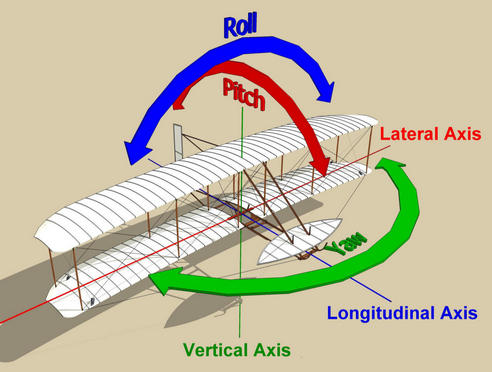
The 1902 Wright glider was the first aircraft with three-axis
control.
|
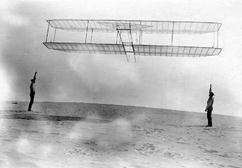
As with all their gliders, the Wright carefully measured the lift
and drag produced by the 1902 glider while flying it as a kite.
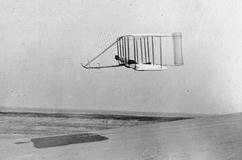
The 1902 glider was the first Wright flying machine to have a
tail. At first, this was only a fixed vertical stabilizer with twin vanes, unable to move.
But the
Wrights found this caused them grief when they tried to turn or level the
wings.
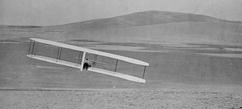
The right wing has dipped on the glider and Orville is attempting to
bring the aircraft back to level flight. He has shifted his hips to
the left, warping the wings and turning the rudder at the same time.
With a fixed tail, this would have been a potentially dangerous maneuver.
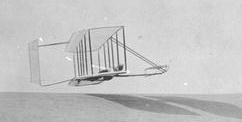
Wilbur raises the nose of the glider to stretch his glide by moving
the elevator ever-so slightly.
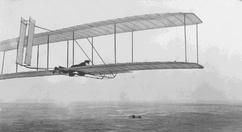
In 1903, while they were readying their powered Flyer I, the Wrights modified
the tail of the 1902 glider again, adding a second movable vane to give the
rudder more authority. They practiced with this, honing their
piloting skills.
|
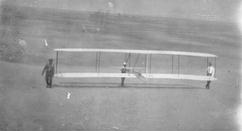
Carrying the 1902 glider us a dune in preparation for a launch.
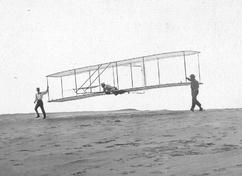
Launching the glider. Orville is at the controls (center), while
Wilbur (left) and Dan Tate (right) run the glider forward into the
wind.
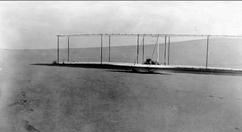
Orville brings the 1902 glider in for a landing in the soft sand.
The anhedral (wing droop) kept the wing tips close to the ground
during this maneuver. Without the droop, the Wrights found a side
gust could catch a wing and overturn the glider.
|